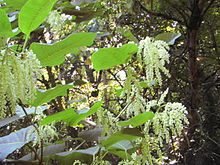Reynoutria sachalinensis
| Reynoutria sachalinensis | |
|---|---|

| |
| Scientific classification | |
| Kingdom: | Plantae |
| Clade: | Tracheophytes |
| Clade: | Angiosperms |
| Clade: | Eudicots |
| Order: | Caryophyllales |
| Family: | Polygonaceae |
| Genus: | Reynoutria |
| Species: | R. sachalinensis
|
| Binomial name | |
| Reynoutria sachalinensis (F.Schmidt) Nakai
| |
| Synonyms[1] | |
| |
Reynoutria sachalinensis (giant knotweed or Sakhalin knotweed Japanese オオイタドリ ooitadori, Russian Горец сахалинский, Гречиха сахалинская; syns. Polygonum sachalinense, Fallopia sachalinensis) is a species of Fallopia native to northeastern Asia in northern Japan (Hokkaidō, Honshū) and the far east of Russia (Sakhalin and the southern Kurile Islands).[2]

Reynoutria sachalinensis is a herbaceous perennial plant growing to 2–4 m (79–157 in) tall, with strong, extensively spreading rhizomes forming large clonal colonies. The leaves are some of the largest in the family, up to 15–40 cm (6–15.5 in) long and 10–28 cm (4–11 in) broad, nearly heart-shaped, with a somewhat wavy, crenate margin. The flowers are small, produced on short, dense panicles up to 10 cm (4 in) long in late summer or early autumn; it is gynodioecious, with male and female (male sterile) flowers on separate plants. The species is closely related to the Japanese knotweed, Reynoutria japonica, and can be distinguished from it by its larger size, and in its leaves having a heart-shaped (not straight) base and a crenate margin. Reynoutria sachalinensis has a chromosome count of 2n=44.[3][4]
Cultivation and uses[edit]

The shoots are tender and edible. It was introduced to Europe and grown in many botanic gardens. It came prominently into notice about 1893, when a drought in western Europe caused a decided shortage in forage for cattle. This plant was little affected, and since its tender shoots and leaves were eaten by stock, the plant was widely grown experimentally as a forage crop. It has proved less useful than was predicted, and its deliberate cultivation has been almost entirely abandoned.[5] It has, however, like F. japonica, proved to be an invasive weed in several areas.[6]
It has hybridised with Reynoutria japonica in cultivation; the hybrid, Reynoutria × bohemica (Chrtek & Chrtková) J.P.Bailey, is frequently found in the British Isles and elsewhere.[3][7]
Extracts of this plant can be used as plant protectants for certain fungal and bacterial diseases.[8][9]
The species has been cultivated as an energy crop for biomass production, particularly in Germany in its commercial variety 'Igniscum', and it has shown a high productivity even in Northern latitudes, reaching a dry matter yield from 5.4 to 27.8 oven dry metric tons per hectare (2.4 to 12.4 short ton/acre), annually.[10]
References[edit]
This article lacks ISBNs for the books listed. (May 2012) |
- ^ The Plant List, Reynoutria sachalinensis (F.Schmidt) Nakai
- ^ "Reynoutria sachalinensis". Germplasm Resources Information Network. Agricultural Research Service, United States Department of Agriculture. Retrieved 1 January 2018.
- ^ a b Flora of NW Europe: Fallopia sachalinensis[permanent dead link]
- ^ Huxley, A., ed. (1992). New RHS Dictionary of Gardening. Macmillan ISBN 0-333-47494-5.[page needed]
- ^ New International Encyclopedia. Yale University Press, 1926.[page needed]
- ^ Sukopp, Herbert; Starfinger, Uwe (1995). "Reynoutria sachalinensis in Europe and in the Far East: A comparison of the species' ecology in its native and adventive distribution range". In Pyšek, Petr (ed.). Plant Invasions: General Aspects and Social Problems. pp. 151–9. ISBN 978-90-5103-097-6.
- ^ Japanese Knotweed Alliance: Fallopia hybrids Archived 2009-10-09 at the Wayback Machine
- ^ "Regalia Biofungicide chemical label" (PDF).
- ^ "Reynoutria sachalinensis (Giant Knotweed) (055809) Fact Sheet | Pesticides | US EPA". 2011-09-09. Archived from the original on 2011-09-09. Retrieved 2017-02-17.
{{cite web}}: CS1 maint: bot: original URL status unknown (link) - ^ Papamatthaiakis, Nikolaos; Laine, Antti; Haapala, Antti; Ikonen, Risto; Kuittinen, Suvi; Pappinen, Ari; Kolström, Marja; Mola-Yudego, Blas (2021). "New energy crop alternatives for Northern Europe: Yield, chemical and physical properties of Giant knotweed (Fallopia sachalinensis var. 'Igniscum') and Virginia mallow (Sida hermaphrodita)". Fuel. 304: 121349. doi:10.1016/j.fuel.2021.121349.
